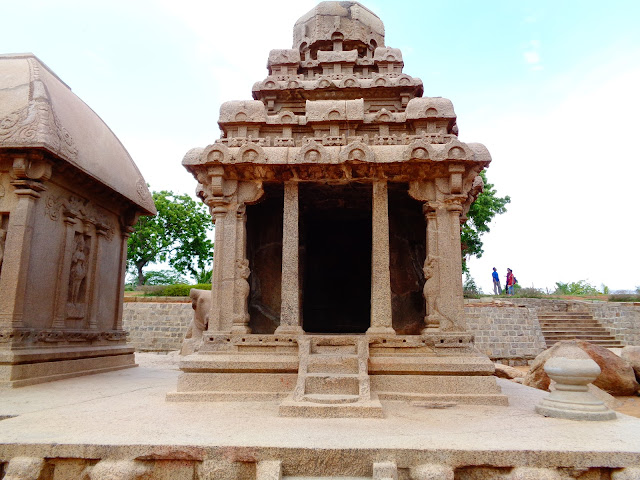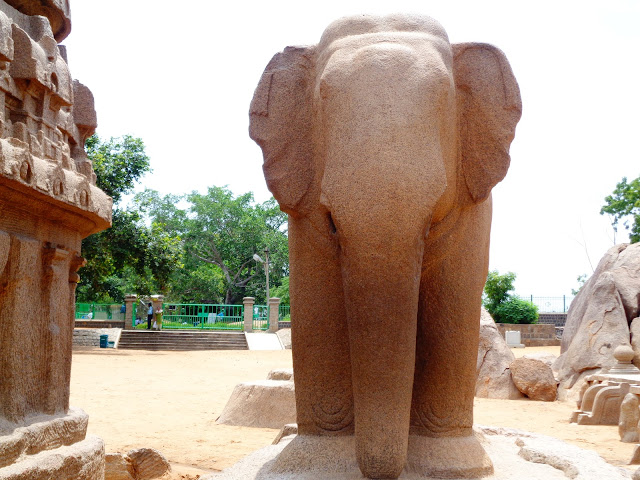Exploring Pallava's Architectures
 |
| Pancha Rathas |
History
The Pallava dynasty was
a South Indian dynasty that existed from 275 CE to 897 CE, ruling a portion of
what is today southern India. They gained prominence after the eclipse of
the Satavahana dynasty, whom the Pallavas served as feudatories.
Pallavas
became a major power during the reign of Mahendravarman
I (571 – 630 CE) and Narasimhavarman I (630
– 668 CE) and dominated the Telugu and northern parts of
the Tamil region for about 600 years until the end of the 9th
century. Throughout their reign, they were in constant conflict with
both Chalukyas of Badami in the north and the Tamil
kingdoms of Chola and Pandyas in the south and were finally
defeated by the Chola kings in the 9th century CE.
The construction of the five rathas is traced back to the 7th
century during the reign of King Mahendravarman I from 600–630 CE and his son
Narasimhavarman I from 630–668 AD of the Pallava dynasty. An ASI inscribed
tablet at the site mentions that the concept of carving the rocks in the shape
of chariots or rathas was made by the Pallava dynasty keeping wooden rathas as
prototypes. Construction work of the structures stopped after the demise of
Narasimhavarman I in 668 AD. These structures illustrating the Dravidian
architecture later became templates to temples of much higher dimensions
constructed in the region subsequently. The reason for constructing the rathas,
most of which have reflections of the Buddhist Viharas and Chaityas is not
known till date. Although there is no connection between the structures and the
Pandavas of the great Indian epic, the ‘Mahabharata’, and ASI proposed
referring the structures as vimanas, but the names of Pandavas has incessantly
remained linked with the structures. In 1984 UNESCO marked the place as World
Heritage Site.
Rathas:
The Entire Pacha rathas Archeitecture were actually resemblance of
Pandava’s vyuham (Military science) at Kurusetra.
 |
| Dharmaraj's (Yudhister) Ratha |
 |
| Draupadi's Ratha |
 |
| Arjuna's Ratha |
 |
| Nakul & Sakadeva's Ratha |
 |
| Bheema's Ratha |
Stone Elephant:
Elephant’s statue resembles Mighty Gajasena ( Army of Soldiers on Elephants )
Lion Statue
Lion statue represents two things one is series of Maharathi Soldiers and second meaning is Lion and Nandhi were Pallava's Royal Symbols.
Nandhi Statue
As I mentioned above Nandi Statue represents one of the Pallava's royal symbol but It also represents War Soldiers since it is in siting posture which mean Backup wave of soldiers.
Hindu Deities statues on Rathas
Lord Ardhanarishvara
 |
| Lord Ardhanarishvara |
Ardhanarishvara
represents the synthesis of masculine and feminine energies of the universe (Purusha and Prakriti) and illustrates how Shakti, the female principle of
God, is inseparable from (or the same as, according to some interpretations)
Shiva, the male principle of God. The union of these principles is exalted as
the root and womb of all creation. Another view is that Ardhanarishvara is a
symbol of Shiva's all-pervasive nature.
Lord Indra
 |
| Lord Indra on his white elephant |
In the Vedas, Indra is the king of Svarga (Heaven)
and the Devas. He is the god of
lightning, thunder, storms, rains and river flows. Indra is the most
referred to deity in the Rigveda. He is
celebrated for his powers, and the one who kills the great symbolic evil named Vritra who obstructs human prosperity and happiness. Indra
destroys Vritra and his "deceiving forces", and thereby brings rains
and the sunshine as the friend of mankind. His importance diminishes in
the post-Vedic Indian literature where he is depicted as a powerful hero but
one who is getting in trouble with his drunken, hedonistic and adulterous ways,
and the god who disturbs Hindu monks as they meditate because he fears
self-realized human beings may become more powerful than him.
Olikaneeswara Temple & Mahishasuramardini Cave Temple
 |
| Olikaneeswara Temple |
The first conventional lighthouse was established in 1887 by
placing a wick lamp inside a 4th order optic and lantern on the roof of Olakkaneeswara
Temple. This temple has been built on top of the Mahishasuramardini cave.
Mahishasuramardini Cave Temple
According to legend,
Durga killed the demon Mahishasura, who was considered unconquerable. Hence, following his
slaying, she was given the title Mahishasuramardhini(conqueror of Mahisha). The granite-carved cave temple depicts the goddess
Mahishasuramardhini, considered an incarnation of the goddess Durga, and is named after her as "Mahishasuramardhini
Cave Temple". The cave's interior relief depicts this battle. The goddess
is shown riding a lion, her several arms holding a bow and arrow, pursuing the
retreating Mahisha with his followers.
 |
| War Between Goddes Durga and Buffalo head demon (Mahisa suran) carved on Cave temple |
 |
| Lord Maha Vishnu on Snake bed craved on another side of the cave temple |
Other Worthy Clicks
------Behind each rock cuts lies an untold history bonded to it. I will try to uncover it ------>
TO BE CONTINUED----










Comments
Post a Comment